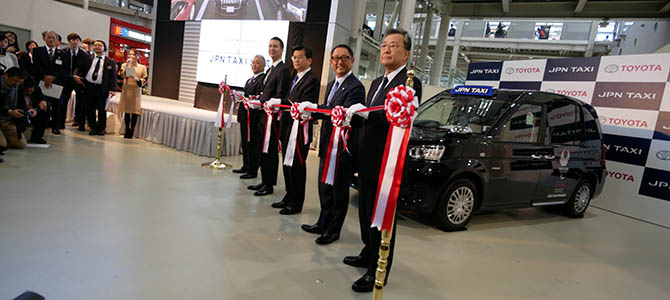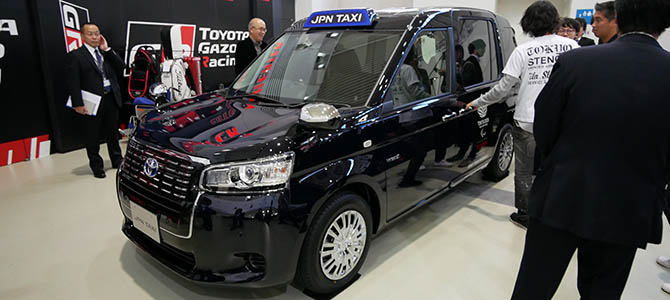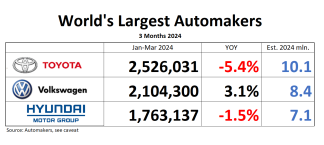Yesterday, I was given an early glimpse of the taxi of the future. It looks a little bit like the offspring of a mésalliance between a London taxi and an Escalade. It will be piloted by a legacy human driver, it won’t have Wifi, it will be powered by propane gas, and its color will be deep blue, if Toyota gets its wish.
The chief engineer of Toyota’s new generation taxi is Hiroshi Kayukawa. In a small room above Toyota’s Tokyo Megaweb complex, Kayukawa prepared a small group of reporters for an epochal event: Next Monday, Toyota’s future taxi will hit the street in the vicinity of Tokyo Station. With that, the 22 years dynasty of the reigning taxi king of Japan and Hong Kong, Toyota’s (Crown) Comfort, will come to an end. (Toyota’s made-for-taxis (Crown) Comfort has nothing to do with Toyota’s big Crown sedan, different platform, confusingly same name.)
The backbone of Japan’s thriving and lucrative taxi business (don’t ever take a taxi from Narita airport into town, or you will be bankrupted) will be succeeded by a totally new development. Yesterday, the new taxi’s name was still a secret. The secrecy will end on Monday, when first pictures will also become available.
On Monday, the first taxi of the future will take to Tokyo’s street in “deep indigo,” a dark hue of blue. According to Kayukawa, Toyota noted that “yellow cabs in New York, and black cabs in London have become symbols of the city and the country.” Toyota wants similar icons for Japan.
In consultation with taxi operators, the company decreed that “Japanese taxis should be in one color, deep indigo.” It’s a typical Japanese compromise: The preferred taxi color in Tokyo is black, and dark blue is not much different, especially not at night, when Tokyo’s taxis are in high demand. A reporter pointed out that Nissan has similar aspirations, and that it wants to turn all Japanese taxis yellow. Kayukawa smiled, and said that “Toyota has taxi market share of 80%.” There are some 230,000 taxis in Japan. In case the color scheme won’t pan out, the taxi will also be available in black, white, and any color you desire, as long as you buy a small fleet. The taxi will be built in Toyoat’s Higashifuji plant, the same where the (Crown) Comfort is being phased out.
The indigo blue taxi will be powered by LPG, or propane gas, feeding a 1.5 liter ICE engine as part of Toyota’s very own hybrid system. Asked why the taxi is neither an EV, nor has any robotic aspiration like the one from Toyota’s cross-town competition at Nissan, Kayukawa said that “at this point in time, hybrid offers the best efficiency.” For the future, Kayukawa did not want to rule out a battery-electric version, but for the time being, BEV taxis are still hampered by the triplicate BEV-bugaboos of price, range and recharge time, he said. Connectivity? The taxi will offer two 2.1 amp USB ports to recharge the traveler’s wary iPhone, but no Wi-Fi. “In the future, that may be a different story,” Kayukawa hinted.
Asked by a freshly landed-in-Tokyo reporter how ride hailing and car sharing services would affect the demand for taxis in Japan, Kayukawa said: “In Japan, not at all.”
Indeed, Uber is down and out in Japan. In Tokyo, the only Japanese city where Uber operates, my Uber map comes up with exactly zero cars on this Friday afternoon. A few weeks, ago, the map showed a handful in this city of 10 million (or 38 million, depending on how one counts.) Why? Simple answer: Tokyo’s taxis are all Uber wants to be: Clean, comfortable, driven by courteous, knowledgeable, and white-gloved drivers. When I book a taxi to go to he (much closer) Haneda airport, the taxi will wait outside 10 minutes before the set time. On top of this, Tokyo, like most Japanese cities, is served by the most efficient transport-as-a-service system the world has seen: Its dizzying network of above-ground and underground trains, so capable that Toyota, like other car companies in Tokyo, routinely puts under its invitations to press events this sentence:
“Due to limited parking spaces in the building and the surrounding vicinity, we would like to request that all guests use the public transport.”
And that’s what I will do when I will see the real taxi on Monday. Update with pics and name to follow.
P.S.: On Monday, the taxi finally was unveiled. Typhoon Lan moved the proceedings indoors. Unveiled also was the name. The chariot is called “JPN Taxi,” demonstrating Toyota’s wish to further monopolize the segment.









